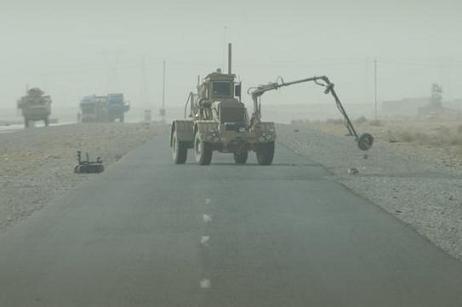CAMP SPEICHER, IRAQ: Investment in “alien-looking” mine-detection equipment by the U.S. military, combined with increased funding for Iraqi police and army units, has cut the number of improvised explosive attacks in the past year in the northern part of the country from 6,000 a month a year ago to less than 500 this month.
Fully 75 percent of IEDs (improvised explosive devices) emplaced in parts of Iraq are now being discovered before they explode, the US Army said. With a growing reconciliation program taking hundreds of Iraqis out of insurgent ranks every month, the millions of dollars spent to design and purchase mine-detection equipment and train soldiers is close to eliminating the attacks that have killed and injured thousands across the country since 2003.
“The technology that has been provided to Combat Engineers in the past five years has saved lives on a grand scale,” said Colonel Matthew Russell, commander of the 18th Engineer Brigade at Camp Speicher, near the city of Tikrit, about 150 miles north of Baghdad. “Either because of scarce resources or perhaps they’re running low on explosives, they’ve had to start emplacing hoax IEDs just to take up our time.”
It’s money that couldn’t be spent fast enough. Improvised explosives became the weapon of choice for insurgents and terrorists who attacked poorly armored Humvees and civilian cars at will from 2004 to 2006. Up to 80 percent of US casualties during the past two years of the conflict had been caused by IED attacks. In 2006, some road patrol units in Anbar province were discovering or setting off up to 10 IEDs each night patrol while covering less than a mile of roadway.
“During the first six months of the war, there weren’t any IEDs,” said Captain Donovan Peterson, commanding officer of the 58th Combat Engineer Company at Camp Speicher. “The whole IED fight is something that the Army had to come up with on its own.”
The 3rd Platoon, 58th Combat Engineer Company has patrolled the main highways between Tikrit, the hometown of Saddam Hussein, and Baiji, where Iraq’s largest oil refinery operates, so many times in the past eight months that the soldiers now notice subtle changes in the trash along the side of the road.
“We know the road so well, we just know when something is different,” said Specialist Matthew Quenga. “It’s like ‘Where the hell did that bag come from?’ Even if it’s something Iraqis just threw out there.”
Patrolling with the engineers highlights the care US soldiers take with potential threats. On this day, suspicion fell on an abandoned tire a few feet off the northbound side of the main Baiji to Tikrit road, only about 200 meters from an Iraqi Police checkpoint. The tire itself was not significant — the amount of trash on Iraq’s roads would exhaust every ‘Adopt a Road’ program in the US. But after months of patrolling experience, one of the soldiers was able to see wires running out from the edge of the tire as they drove past in the southbound lane.
Several soldiers, talking over the radio among the five-vehicle mission, believed the tire was a hoax. Bomb installers have increasingly placed propane tanks, tires, and water jugs on the side of the road, in the hope of perhaps lulling Iraqi Police and US Army patrols to complacency before resuming attacks with real bombs.
To combat the explosive tire, engineer battalions now use several pieces of newly developed equipment that have little use outside of bomb discovery. The first looks like a mating of an industrial road-grader and a pawn-shop robotic arm.
Called a ‘Husky’, the South African-made mine detector allows its single operator to control a 20-foot-long robotic arm with a camera and two-pronged claw at the end to find out what is inside an abandoned tire, all at a safe distance. The occupant of the Husky sits 12 feet above the ground in a blast-proof cab.
In this case, the tire was holding an anti-tank mine, probably Italian or Chinese-made, containing enough explosives to seriously damage a vehicle if it ran directly over it.
To destroy the tire bomb, the Army has come to depend on an even more outlandish, but highly effective piece of equipment – the Talon – a robotic remote-controlled tread vehicle with an on-board video camera to verify and then destroy the IED without putting humans in harm’s way. The Talon can then use a small robotic arm to carry counter-charges, in this case, two sticks of C-4 explosive with a time-fuse.
About an hour after the IED was discovered, the platoon destroyed it with explosives, allowing traffic on the four-lane road to return to normal, and adding one more ex-IED to the more than 150 the company has destroyed in the past eight months.









5 Comments
I’ve been waiting to see when ground-penetrating radar will be used for this chore. It can even be deployed by aircraft at altitude.
Great piece! It’s good to see the military permitting some information on the IED fight to be released these days.
My only complaint about the article is that the HUSKY is not new equipment. The concept, as well as other related vehicle, have been around for years. It just took the US Military a year or two of IEDs to realize the worth of IED-defeat specific vehicles.
@jeandon:
I’m not going to say anything specific here about any military equipment or capabilities thereof, but GPR is pretty useless in theater.
Thanks Bill Murrey – wonderful report.
Great article
Pawn shop arm…LOL! We designed the lightweight arm here at Ft Belvoir and wanted it as simple and low-cost as possible. However simple and low-cost usually does not guarantee program visibility. But they are the options of last resort when hi-cost and hi-tech don’t work.